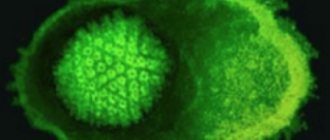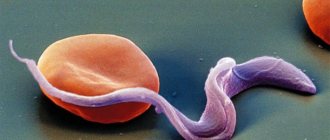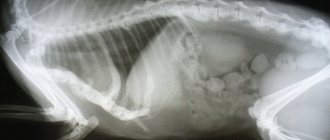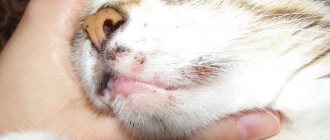Causes of the disease
The disease is transmitted through contact with an infected animal and often has no external manifestations. There are many strains of the disease, but the two most dangerous are M. gateae and M. Felis. One of the varieties of mycoplasma is the strain that causes hemoplasmosis in cats. This disease leads to the development of anemia.
Cat with advanced disease
The bacterium finds favorable conditions for reproduction in the cell: nutrients, the right temperature.
At risk are cats with weakened immune systems and those in contact with stray animals.
Routes of infection
The disease is transmitted by airborne droplets, sexually, and during birth from the mother to the kitten. Mycoplasma bacteria are found in all environments, including soil; a cat can become infected even while walking outside. The habitat of infection is the conjunctiva, respiratory tract.
Next, we will consider in more detail how mycoplasma manifests itself in cats, the symptoms of the disease and methods of treatment.
Prevention of mycoplasmosis
There is no vaccine to prevent the development of mycoplasmosis yet, but following certain recommendations can help protect the animal from this pathology. Preventive measures include:
- compliance with the principles of proper and balanced nutrition when feeding the animal;
- exclusion of contact between the pet and yard animals;
- enriching your pet’s diet with vitamins and immunomodulatory supplements;
- regular examinations by a specialist.
Signs of the disease
Chlamydia in cats: symptoms, treatment, danger to humans
Mycoplasmosis in cats has the symptoms of a cold, and often incorrect treatment is carried out at home, without examination by a veterinarian. The first symptoms of the disease appear 5 days after infection:
- temperature increase,
- refusal of food,
- lethargy,
- cough,
- copious discharge from the eyes,
- swelling of the joints,
- enlarged lymph nodes.
With complications, the disease can provoke the development of cystitis, nephritis, joint disease, and miscarriages.
Asymptomatic mycoplasmosis in cats
With a mild course, mycoplasmosis in cats can be asymptomatic and go away without treatment.
Mycoplasmosis under a microscope
Mycoplasmosis can be in a dormant form and also not show any external symptoms, but over time there is a risk of becoming chronic, so the disease must be treated.
How to understand that your pet has become infected with mycoplasma
The disease has a long incubation period. Owners of infected animals may not realize for several weeks that their pet has health problems. Diagnosis is complicated by the fact that in some cases mycoplasmosis is asymptomatic.
The clinical picture of the pathology is vague and depends on the location of the parasites, the immune status of the cat and its age. Symptoms can vary and occur with varying degrees of intensity and severity. In the early stages, the disease may resemble a common cold.
General symptoms of mycoplasmosis in cats
- Anemia.
- Lethargy, apathy, drowsiness.
- Decreased appetite, anorexia.
- Decreased physical activity, weakness.
- Increased body temperature, fever.
- Jaundiced skin color.
- Paleness of the skin and mucous membranes.
- Changes in behavior, depression.
- Tearing.
- Purulent and serous discharge from the eyes and nose.
Signs depending on the location of the parasites
- Rhinitis, sneezing, dry cough.
- Difficulty breathing, shortness of breath.
- Swelling and pain in the joints. Arthritis.
- Gait disturbance, problems with movement.
- Infectious diseases of the urinary tract. Cystitis.
- Prostatitis.
- Involuntary urination.
- Pneumonia, bronchitis.
- Conjunctivitis.
- Enlarged lymph nodes and spleen.
- Purulent inflammation, ulcers and erosions on the skin.
- Reproductive problems: spontaneous abortion, infertility, stillbirth.
If any of these signs appear, you must immediately take your pet to a veterinarian to make a diagnosis and prescribe a treatment regimen.
Diagnosis of mycoplasmosis
Piroplasmosis in cats: symptoms and treatment
If your cat shows signs of illness, you should contact a veterinary clinic as soon as possible.
Note! If you notice symptoms of the disease, you should not postpone your visit to the doctor. The sooner treatment is prescribed, the less harm the disease can cause to the animal.
To determine the disease, an external examination is carried out, temperature is measured, and a number of tests are taken:
- analysis for mycoplasmosis using PCR;
- blood test to determine the inflammatory process in the body;
- urinalysis - determines the condition of the genitourinary system and sensitivity to antibiotics.
Symptoms of mycoplasmosis
It is difficult to name specific manifestations of mycoplasmosis in cats. The pathology affects many systems - respiratory, genitourinary, and can cause conjunctivitis or joint problems. It happens that mycoplasmosis is asymptomatic or is characterized by a whole complex of symptoms, which may include:
- general weakness, apathy;
- redness of the eye membranes, lacrimation, inflammation of the conjunctiva;
- respiratory problems;
- fever;
- swelling of the paws, joint pain;
- problems with urination and digestion.
None of these manifestations can accurately indicate the development of mycoplasmosis, but any change in the animal’s condition is a reason to contact a specialist. In the absence of timely treatment, the animal may experience urethritis, cystitis, infertility, arthritis, bronchitis or pneumonia.
Inflammation of the conjunctiva, redness and lacrimation may be symptoms of mycoplasmosis
It happens that mycoplasmosis is asymptomatic. In this case, a sharp decrease in the body’s protective functions due to bacterial activity manifests itself in weakness and chronic drowsiness.
How to treat a pet
Distemper in cats: symptoms and treatment at home
Mycoplasma in cats is treated with antibiotics. If the disease is advanced and the animal’s organs are already affected, medications are prescribed to treat complications. It is important to choose the right medications, since improper treatment can complicate the course of the disease and make it chronic.
For a speedy recovery, treatment must be supplemented with immunostimulating interferon drugs.
To eliminate discharge from the eyes and nose, drops are used to wash these organs.
The speed of recovery depends on the correct selection of medications, the cat’s immune system, and quality care for the sick pet; homeopathy can serve as an addition to treatment.
Approximate regimen for taking antibiotics
To cure a cat, an antibiotic of the tetracycline group is prescribed. The duration of treatment is 7-14 days, depending on the severity of the disease.
To maintain liver function, hepatoprotectors should be given, taken simultaneously with antibiotics. Drugs are administered to restore beneficial flora of the gastrointestinal tract.
Diet for the duration of treatment
During the treatment of mycoplasmosis in cats, it is necessary to provide the cat with a nutritious diet rich in protein foods and vitamins. Portions should be small so that the body can more easily cope with processing. A balanced diet will help your cat recover faster.
Caring for a sick pet
Symptoms of the disease may disappear after 5 days of taking medication; the advanced form will have to be treated for up to several months.
Cat treatment
During the treatment period, the cat must be provided with rest, equipped with a comfortable bed, constant access to water, try not to bother with attention, and constantly clean the cat litter box.
Possible complications
If treated incorrectly or untimely, the cat may develop pneumonia, polyarthritis, and nephrosis. The combination of two strains of mycoplasmosis at the same time is especially dangerous. An advanced disease can lead to the death of a cat!
How is mycoplasmosis treated?
The treatment regimen depends on the location of the infection, the degree of parasite activity, and the severity of the disease. A few days are enough to relieve the symptoms of the acute form of the disease. Treatment of chronic mycoplasmosis can last for several months.
Preparations:
- Antibiotics: tetracycline, doxycycline, bicillin, azithromycin, enrofloxacin, chloramphenicol.
- Analgesics. To relieve pain and fever.
- Steroids: prednisone.
- Immunomodulators: feliferon, interferon, mycoplasma immuno.
At the same time, symptomatic treatment and supportive therapy are carried out: the mucous membranes are treated to remove purulent discharge, and courses of probiotics and vitamins are prescribed.
Is the disease dangerous for humans?
The type of mycoplasmosis that cats suffer from is not dangerous to humans. However, you should limit contact with a sick cat. Mycoplasmosis can be detected in a person with reduced immunity.
- For men.
For a man's body, mycoplasmosis does not pose a danger, but he can be a carrier of an infection that will be transmitted through touch, clothing and outdoor shoes.
- For women.
Infection with mycoplasmosis is dangerous for pregnant women, since the disease reduces immunity, which creates favorable conditions for infection with other diseases that are more dangerous for the expectant mother and child.
Danger to other pets
Kittens are most susceptible to infection, as they do not yet have strong immunity. Mycoplasmosis in kittens can already be present in the womb. The disease can be transmitted through household items - toys, rugs, shoes, human outerwear.
Important! A sick animal must be isolated from other pets to prevent infection.
Mycoplasmosis therapy
If the diagnosis confirms the presence of mycoplasmosis, the specialist prescribes complex therapy, which can be successfully carried out at home. To get rid of the disease and alleviate the condition of the animal, the following drugs are prescribed:
- antibiotics for oral use - Tetracycline, Azithromycin, Levomycetin, Baytril;
- immunostimulants - Immunofan, Ribotan;
- to restore the normal functioning of internal organs - Karsil, Katozal, probiotics.
In addition, the mucous membranes are regularly washed with water and treated with Tetracycline ointment. The dosage and duration of therapy should be determined by a specialist. If all recommendations are followed, the pet’s condition will improve in a few days, and full recovery will occur in 2-3 weeks.
Not all antibiotics are acceptable in the treatment of mycoplasmosis in cats bearing offspring and kittens up to three months. A specialist usually prescribes Vilprafen for pregnant pets and furry babies.
Danger of infection for humans
There is a danger of infection for humans, especially for those categories that have a weakened immune system. This includes small children under 3 years old, as well as:
- people with immunodeficiency virus;
- patients with chronic pathologies;
- those forced to undergo chemotherapy, as well as those who have recently undergone surgery.
It is worth noting that the likelihood of contracting mycoplasmosis directly from a domestic cat is much less than the strain that affects humans. But for the purpose of prevention, veterinarians recommend not to interfere or have close contact with domestic cats that have been diagnosed with mycoplasmosis. It is also not advisable to hand feed a sick animal until it has fully recovered.
In order to prevent infection with mycoplasmosis, it is necessary to thoroughly and regularly wash your hands with soap and treat with antiseptic agents.
Diagnosis and treatment
If an animal has signs of mycoplasmosis, it must be taken to a veterinarian immediately. After reviewing the history, the doctor will perform a physical examination of the cat and order a complete blood test.
Pneumonia is a common complication after mycoplasmosis.
If an infection actually develops in the pet’s body, laboratory tests reveal anemia - a low level of red blood cells.
Along with this analysis, it is also recommended to do:
- screening;
- flow cytometry analysis (considered the most informative method for diagnosing mycoplasmosis);
- analysis of the genital mucosa;
- smear of the eye shell.
If the diagnosis is confirmed during the diagnosis, treatment of mycoplasmosis in cats is carried out immediately. There is no specific treatment regimen for this disease. It all depends on the severity of clinical manifestations and the general condition of the animal.
Be sure to read:
What is dangerous about toxoplasmosis, symptoms and treatment of the disease in cats and people
Antibacterial therapy is prescribed in any case. It suppresses bacterial growth and improves the pet’s well-being.
The choice of antibiotics is made individually after a special susceptibility test. If the pet is found to have severe anemia, a blood transfusion is performed.
In addition to antibacterial therapy, symptomatic treatment is also carried out, which includes taking astringent, analgesic and antiemetic drugs.
Quite often, the only sign of mycoplasmosis in cats is weakness of the animal.
Also during this period it will be useful for the animal to take medications and dietary supplements that help improve the functioning of the digestive system.
To speed up the recovery process and prevent the development of complications due to mycoplasmosis, it is recommended to give the animal immunomodulatory drugs.
Important! If mycoplasmosis in cats manifests itself with severe symptoms, then treatment is carried out in a hospital.
Only after the pet’s condition returns to normal is it given back to its owners, but the therapy does not end there. At home, you will also need to ensure that the animal takes all necessary medications, proper nutrition and rest.
Medicines
All medications for the treatment of mycoplasma in an animal, their dosage regimen, dosage and duration are determined by the doctor individually. However, there are some medications that are used in almost 90% of cases.
Doxycycline and chloramphenicol are broad-spectrum antibiotics that are highly effective in combating pathogens of mycoplasmosis.
Veterinarians prescribe azithromycin to support pet immunity
Positive results from taking them are observed already on the second day. If an animal shows intolerance to these drugs, then they are replaced with Tylosin or Baytril.
For this disease, the following are also often prescribed:
- Karsil, Katozal or Gamavit - these products stimulate the functioning of internal organs.
- Cycloferon, Immunofan or Ribotan - the action of these drugs is aimed at strengthening the immune system.
- Tetracycline has an antibacterial effect and is used to treat affected mucous membranes of the eyes and genitals.
Caring for a cat when sick
To prevent the development of complications due to mycoplasmosis in a cat and treatment to produce quick results, the animal must be provided with proper care.
All medications for the treatment of mycoplasma in an animal, their dosage regimen, dosage and duration are determined individually by the doctor.
If there are no other pets in the apartment, there is no need to isolate him. It’s enough just to create a comfortable and convenient lounger for him.
To avoid causing unnecessary suffering to the cat, you should not pick it up. This is due to the fact that with the development of mycoplasmosis, all joint and bone tissues of the animal are affected, and any movements can cause severe pain.
Important! Bathing, combing and walking your pet during the treatment period is prohibited.
Diet for the duration of treatment
At the time of treatment, the cat's diet should be adjusted. If she is fed at home, you need to make sure that the food she eats is fresh and prepared from high-quality products.
Be sure to read:
What is dangerous about toxoplasmosis, symptoms and treatment of the disease in cats and people
It is important to provide the animal with plenty of fluids, vitamins and minerals. To replenish the latter, you can use special vitamin complexes for pets. When choosing them, you must take into account the age and weight of the cat.
Description of mycoplasmosis
Mycoplasmosis most often affects the body of a weakened animal. The causative agents of mycoplasmosis in cats belong to the category of facultative aerobic parasites, occupying an intermediate position between fungi, bacteria and viruses.
Their main feature is that they have the ability to change their shape, since they do not have cell walls, which significantly complicates the process of diagnosing the disease.
M. gatae and M. felis are capable of surviving outside a living organism for some time.
However, when unfavorable conditions arise (low temperatures, high levels of UV, exposure to chlorine-containing agents, etc.) they quickly die.
But despite this, they show high resistance to some antibacterial drugs. They mainly live on ground surfaces, plants, household items and in water.
They have several transmission routes:
- airborne;
- contact (during games, fights, etc.);
- sexual;
- during pregnancy and labor (from an infected cat to offspring);
- during blood transfusion.
Penetrating into the animal's body, mycoplasmas begin to actively secrete endotoxins, which provoke the activation of destructive and degenerative processes in tissues, which subsequently leads to their destruction and disruption of their functionality.
What is the danger of pathology?
Asymptomatic development of infection can lead to inflammation of the pet’s joints.
Mycoplasmosis is dangerous because sometimes it does not manifest itself at all. However, the pathogen develops in the body and affects internal organs and systems. And when the owner notices that something is wrong with the four-legged pet, often the disease is already at a progressive stage, which is much more difficult to combat. Other complications that often accompany the disease are:
- pulmonary pneumonia;
- damage to the digestive tract;
- inflammation of the genitourinary system;
- damage to the mucous membrane of the visual apparatus;
- arthritis.
Treatment
There is no specific treatment regimen against mycoplasmosis. Therapy is carried out comprehensively and includes the use of:
- Antibiotics.
- Expectorant drugs.
- Vitamins.
- Immunostimulants.
Attention! Diet is an essential part of treatment.
Antibiotics for cattle against mycoplasmosis are used intramuscularly or orally. In the event of the spread of respiratory mycoplasmosis in a herd, it is advisable to use them in the form of aerosols for a whole group of sick animals. List of drugs used to combat mycoplasma:
- Levomycetin;
- Enroflon;
- Tetracycline;
- Tetravet;
- Biomutin;
- Tiamulin;
- Dibiomycin;
- Terravitin.
Reference. The course of antibiotic treatment is continued for up to 7 days. The dosage is prescribed by the veterinarian.
An approximate treatment regimen for a group of calves infected with mycoplasmosis looks like this. Terravitin 500 is given orally at a dosage of 20-40 mg/kg in the morning and evening. At the same time, Trimerazin is given orally twice a day (dosage - 1 mg for every 15 kg of weight). The long-acting drug Biovit is given with food once a day, 3-5 g to each calf. Along with these medications, it is necessary to include ascorbic acid in the treatment regimen at a rate of 1 g per day.
The drug Biovit
Norsulfazole solution is administered intravenously. It is prepared like this:
- 600 ml distilled water.
- Glucose solution at a concentration of 40% - 300 ml.
- Rectified alcohol 96% - 300 ml.
- Norsulfazole in powder form – 40 g.
The prepared solution is administered once a day to each sick individual into a vein, 50 or 60 ml for 3 days. The next 4 days use a different solution for intravenous injection. It is administered to sick calves once a day, and is prepared from the following components:
- Calcium chloride in the form of a solution at a concentration of 10% - 15 ml.
- Glucose solution 40% - 25 ml.
- Hexamethylenetetraamine solution 40% - 10 ml.
- The fourth component is a solution of caffeine sodium benzoate (20%) - up to 3 ml.
To stimulate the discharge of sputum from the upper respiratory tract, animals are given mucolytics and expectorants to drink. To strengthen the body's resistance, the treatment regimen for mycoplasmosis includes B vitamins (mainly B12), as well as globulins or plant immunostimulants, for example, Eleutherococcus.
Important! To improve intestinal function and restore microflora, it is advisable to give cows probiotics.
Animal mycoplasmosis
Mycoplasmosis is a contagious animal disease characterized by damage to the upper respiratory tract, serous-catarrhal inflammation of the lungs, serous integument, keratoconjunctivitis, arthritis in young animals, abortions in pregnant animals, endometritis, mastitis and the birth of a dead, non-viable offspring.
Historical reference
The first report of widespread pneumonia in cattle was made in 1699 and belongs to J. Valentini. The infectious nature of contagious pleuropneumonia was established in 1765, and in pigs the causative agent of this disease was identified in 1903 by W. Grips.
Spread of the disease
Animal mycoplasmosis is recorded on all continents of the globe. It is also registered in the Republic of Belarus.
Economic damage
The economic damage caused by this disease consists of mortality, forced slaughter, loss of live weight, offspring, quality of the resulting products, costs of treatment, prevention and its elimination.
Etiology
The causative agent of the disease is mycoplasmas belonging to the family Mycoplasmataceae, the genus Mycoplasma, species that cause corresponding diseases in animals: M. bovis (pneumoarthritis of cattle), M. bovoculi (keratoconjunctivitis), M. ovipneumoniae (mycoplasma pneumonia of sheep); M. suipneumoniae, M. hyopneumoniae (enzootic pneumonia of pigs); M. hyorhinis M. hyosynoviae M. granularum M. hyoaptrinosa (porcine polyserasitis and polyarthritis); M. mycoides (contagious pleuropneumonia of cattle, infectious pleuropneumonia of goats); M. agalactiae (infectious agalactia of sheep and goats). Mycoplasmas belonging to the genus Ureaplasma and the species U. diversum cause ureaplasmosis in cattle. The causative agents of mycoplasmosis, belonging to the family Acholeplasmataceae, the genus Acholeplasma and the species A. granularum and A. Laidlawii, cause polyserositis and polyarthritis in pigs.
Mycoplasmas are free-living prokaryotic microorganisms. In terms of the level of structural organization, they occupy an intermediate position between viruses and bacteria. Unlike viruses, mycoplasmas are capable of independent reproduction, and unlike bacteria, they lack a cell wall (limited only by the plasma membrane) and are not able to synthesize its biochemical precursors. According to their biological properties, mycoplasmas are divided into saprophytic, parasitic and pathogenic. In terms of cultural and morphological properties, mycoplasmas and viruses differ little from each other. Mycoplasmas stain well according to Romanovsky-Giemsa and Deans, and are gram-negative.
For the cultivation of mycoplasmas, cell-free (modified Edward's medium) and cellular (RKE, primary cultures) media are used. Mycoplasmas are resistant to low temperatures and can be stored for up to a year when frozen. Sunlight and air drying kill mycoplasmas within 4-5 hours. They survive in rotting material for up to 9 days. Freeze-dried mycoplasmas are virulent for over 5 years. At high temperatures, the pathogen is quickly inactivated. Mycoplasmas are sensitive to the effects of antibiotics and sulfonamides. Conventional disinfectants in generally accepted concentrations quickly and reliably neutralize the pathogen on environmental objects.
Epizootological data
Animals of all ages are susceptible to mycoplasmosis, but young animals are more sensitive. The source of the causative agent of mycoplasmosis infection are sick and recovered animals, in whose bodies mycoplasmas can persist for up to 13-15 months.
The pathogen is released into the external environment through discharge from the nose, eyes, mucus when coughing, with milk, urine and other secretions. Transmission factors are feed, water, bedding, care items, etc. contaminated with mycoplasmas. Infection occurs through airborne droplets, nutritional means, contact routes, and also in utero.
There is no pronounced seasonality in mycoplasmosis, but the greatest number of cases of the disease occurs in the autumn-winter period. The disease is characterized by stationarity, which is explained by a long period of carriage of the pathogen in the body of recovered animals (infection of the herd persists for years). The disease occurs in the form of enzootic outbreaks. The breadth of distribution, the intensity of the epizootic process and the severity of the disease are significantly influenced by the microclimate of the premises, the conditions of feeding and keeping animals.
Course and symptoms of the disease
For pneumoarthritis in cattle, the incubation period is 7-26 days. Calves get sick from the first days of life. They experience decreased appetite, depression of general condition, serous and then mucous discharge from the nose, increased body temperature up to 40.5 ° C and cough. As the disease progresses, the general condition sharply worsens, profuse mucopurulent discharge from the nose appears, rapid, shallow breathing, frequent and wet cough, and wheezing in the lungs is heard on auscultation. Many sick calves show signs of damage to the vestibular apparatus: they tilt their heads to one side or the other and make manege movements. After 20 days, polyarthritis develops. Sick calves develop lameness, stiffness and limited movement. The affected joints are swollen and hot. In cows with this disease, the udder is affected. It becomes swollen, hot, painful. The milk turns yellowish and contains flakes. Milk yields are declining sharply.
In some calves, mycoplasmosis may manifest as keratoconjunctivitis. At the same time, sick animals show anxiety and photophobia. Often calves have their eyes closed. Subsequently, the conjunctiva becomes red, lacrimation appears, the reaction to light increases sharply and inflammation spreads to the cornea, causing keratitis. The cornea becomes cloudy and takes on a gray tint. A red ring forms around it, after which blindness occurs.
The main symptom of genital mycoplasmosis (ureaplasmosis) in cows is the discharge of purulent exudate from the vagina, which dries on the tail hair in the form of crusts and scales. The mucous membrane is hyperemic, a large number of small bright red nodules are revealed on its surface, as a result of which it becomes rough. In pigs, ureaplasmosis is manifested by massive infertility of sows and abortions, which are recorded in the first 1.5 months of pregnancy. When sows are artificially inseminated with sperm infected with ureaplasma, infertility reaches 100%. The number of stillborn piglets in the litter is 1-2%, and their death before weaning is 10-11%. In infected sows inseminated with sperm from healthy boars, infertility rates range from 20 to 25%, the number of stillborn piglets reaches up to 0.4%, and mortality from birth to weaning is 5%. Often the sexual cycle increases from 30 to 120 days.
For mycoplasma arthritis and polyserositis, the incubation period lasts 3-10 days. The disease occurs acutely and chronically. Acute in piglets 3-10 weeks of age. They experience increased body temperature, loss of appetite, inactivity, increased sensitivity in the abdominal area, and difficulty breathing. Two weeks after the first signs of the disease appear, swelling of the joints and lameness are detected.
In piglets older than three months, the disease occurs suddenly and manifests itself as lameness. Body temperature is usually within the physiological norm. Several joints of different limbs are involved in the pathological process. In the area of the affected joint, the skin is swollen, the piglets are depressed, the appetite is reduced and, as a result, the gain in live weight decreases. Clinical signs of joint damage are not always clearly expressed. In these cases, animals often change body position, take an unnatural pose, or stand motionless for a long time. Sometimes piglets stand on their wrist joints and have difficulty getting up.
For respiratory mycoplasmosis in pigs, the incubation period lasts from 7 to 30 days. Body temperature can rise to 40.1 -40.5 ° C, then the general condition and appetite worsen. Piglets experience sneezing, mucous discharge from the nose, and coughing - initially dry and rare, and then in the form of prolonged attacks. Breathing is increased to 70-80 movements per minute. The cough is especially worse in the morning when getting up or when moving animals.
When the main pathological process is complicated by bacterial microflora in piglets, the disease is more severe. Breathing becomes difficult, appetite is reduced, exhaustion is noted, the mucous membranes are cyanotic. At the final stage of the disease, piglets experience severe shortness of breath; they sit on the back of the body and try to exhale air from collapsed, inelastic, chronically inflamed lungs with abdominal blows.
In sheep, mycoplasma pneumonia begins in the first weeks of life and manifests itself in the form of mild wheezing, which is detected only by auscultation of the chest. Then a wet cough and serous-mucous discharge from the nose appear. With infectious agalactia of sheep and goats, fever, depression, and loss of appetite are observed. Subsequently, mastitis develops (more often - one lobe of the udder). Subsequently, with a decrease in milk production, complications develop - damage to the joints and eyes is noted. In cases of recovery, the original milk production is not restored.
Pathological changes
When autopsying dead animals, in most cases, hyperemia of the mucous membranes of the nasal cavity is detected. In the initial or latent period of the disease, multiple bronchopneumonic foci are found in the lungs (usually in the apical lobes) in the middle and main lobes. Such lobular lesions have a gray or gray-red color with a dense consistency when cut. Interlobular and interlobular connective tissue are gray-white strands that divide the lung parenchyma into lobules and lobes. Mucopurulent exudate is released from the bronchi of the lungs. The walls of the bronchi are thickened and gray in color. The mediastinal and bronchial, and often the prescapular, submandibular and retropharyngeal lymph nodes are enlarged and hyperemic. After complications of the mycoplasma process with secondary bacterial microflora, necrotic foci are found in the lungs. Regional lymph nodes on the incision are swollen and hyperemic, with necrotic foci. The kidneys are slightly increased in volume, the border between the cortex and medulla is smoothed, and hemorrhages are sometimes observed. Dystrophic changes are observed in the liver and kidneys. The spleen is slightly swollen.
When the eyes are affected in animals, hyperemia and swelling of the conjunctiva, injection of blood vessels, clouding and roughness of the cornea are noted. When the mammary gland is affected, the consistency of the parenchyma is dense, and there is a proliferation of connective tissue in the interlobular spaces. Abscesses are possible.
In cows with damage to the genital organs, swelling of the uterine mucosa, thickening of the oviduct and accumulation of serous or serous-purulent exudate in their lumen, catarrhal-purulent endometritis and salpingitis are noted, and in bulls - vesiculitis and epididymitis.
In pigs during the acute course of the disease, serous-fibrinous pericarditis, pleurisy and peritonitis are noted. Changes in the joints are characterized by swelling and hyperemia of the synovial membranes with a large accumulation of synovial fluid. In the subacute period, changes are mainly localized in the serous membranes. The synovial membrane loses its luster, thickens and hypertrophies, and the synovial fluid becomes thicker. In the chronic course of the disease, organized fibrinous foci of adhesion are detected on the pleura and pericardium. The synovial membrane of the joints is sharply thickened and hyperemic, and some areas are covered with fibrinous masses. The volume of synovial FLUID is increased, sometimes with an admixture of fibrin. The joint capsules are thickened, and contractures are sometimes observed.
Diagnostics
The diagnosis of mycoplasmosis is made comprehensively, taking into account epidemiological data, clinical signs, pathological changes, results of bacteriological and serological studies.
For research, bronchial and mediastinal lymph nodes, pieces of affected lungs (at the border of healthy and diseased tissue), spleen, liver, brain, aborted fetuses, stillborn fetuses (or their organs), unopened affected joints, and milk for mastitis are sent to the laboratory. For inflammation of the upper respiratory tract, nasal mucus and nasal washes can be examined.
Pathological material is selected no later than 2-4 hours after the diagnostic slaughter or death of the animal and sent to the laboratory in a frozen thermos with ice. The material must be obtained from an animal that has not been treated. For intravital diagnostics, paired blood serum samples can be taken (the first sample is at the onset of the disease, again after 14-20 days).
In the laboratory, microscopy of fingerprint smears, inoculation on nutrient media, identification of isolated cultures by cultural and biochemical properties, as well as on the basis of serological properties are carried out (for this, RA, RNGA, RSK and the enzyme-linked immunosorbent method are used). The diagnosis is considered established when a culture of the pathogen is isolated from the primary pathological material and its identification; when the antibody titer increases 4 times or more in paired blood serum samples.
Differential diagnosis
In cattle, mycoplasmosis should be differentiated from RTI, PG-3, respiratory syncytial infection, viral diarrhea, adenoviral infection, chlamydia, pasteurellosis, leptospirosis, brucellosis.
In pigs - from hemophilus polyserositis, hemophilus pleuropneumonia, erysipelas, influenza, chlamydia, salmonellosis, brucellosis, leptospirosis, classical swine fever. In sheep - from erysipelas and staphylococcal polyarthritis, pasteurellosis, adenomatosis.
Differentiation of diseases is carried out on the basis of epizootic data, clinical signs, pathological changes, but the main method is laboratory (results of virological, serological and bacteriological studies).
Treatment
Specific treatments for animals with mycoplasmosis, developed to date, do not have a pronounced therapeutic effect, so intensive work is being done to improve them. For therapeutic purposes, you can use convalescent serum, which is produced on the farm where the disease occurred.
Treatment should be comprehensive and include etiotropic, pathogenetic, symptomatic and dietary therapies. The greatest therapeutic effect can be obtained in the initial stages of an animal’s disease. During this period, drugs to which mycoplasmas are sensitive are used: tylanic, fradiazine, chloramphenixol, chloramphenixol, chloramphenicol, tetracycline, macrolides, tiamulin, chlortetracycline, enroflon, spelink, colivet, gellimycin, tetravet, tilar, spectam, biomutin, etc. It should be borne in mind that that these drugs do not destroy mycoplasmas located inside the cells of the body, so some animals, after treatment, become mycoplasma carriers.
The therapeutic effectiveness of antibiotics increases markedly when they are used in the form of complex forms of prolonged action on a polymer basis. For example, when prescribing dibiomycin in combination with polyethylene glycol or trivitamin. For respiratory mycoplasmosis, a positive therapeutic effect is obtained with aerosol use of drugs. Aerosol generators (SAG, VAU-1) are placed in a room or a special treatment chamber at the rate of one device per 200-250 m3 of area or 550-650 m3 of room volume. They are suspended at a height of 80-120 cm <>t floor level. The generator operates using a compressor that supplies compressed air under a pressure of 4-4.5 atm. The duration of the inhalation session is 30-60 minutes. The full course of treatment with aerosols of antibiotics and sulfonamides with daily treatment should be 7-10 days or more, depending on the severity of the pathological process and the clinical condition of the animals.
Internally in a group method you can use: Terravitin-500 20-40 mg/kg of animal weight 2 times a day, trimerazin 1.0 per 15 kg of live weight 2 times a day, Biovit-120 3-5 g per animal 1 time per day day, ascorbic acid 1 ml per animal once a day. Vetdipasfen 1.5-2 g and aspirin 1.0 g per animal twice a day, ascorbic acid 1.0 g once a day. The course of treatment is 6-7 days.
To treat sick calves, use a mixture consisting of a 40% glucose solution - 300 ml, 96% rectified alcohol - 300 ml, distilled water - 600 ml, soluble norsulfazole - 40 g. Intravenously, 50-60 ml of solution per animal Once a day for 3 days in a row. On the 4th day of illness after administration of the first composition, the following composition is used: 10% calcium chloride solution - 15 ml, 40% glucose solution - 25 ml, 40% hexamethylenetetraamine solution - 10 ml, 20% solution caffeine sodium benzoate - 2-3 ml. Intravenously, once a day, course of treatment is 4 days.
For young animals of all types of animals, you can use a mixture consisting of 96% rectified alcohol - 75 ml, physiological solution - 250 ml, glucose powder - 25 g, sulfacamphocaine - 6-8 ml. Intravenously, at the rate of 0.5 ml per 1 kg of live weight, 1 time per day. The course of treatment is 5 days.
To restore respiratory function, improve air exchange, liquefy and facilitate the removal of exudate from the bronchi, expectorants are used internally along with chemotherapeutic agents: ammonium chloride, antimony trisulphide, terpene hydrate, potassium iodide, sodium bicarbonate, sulfur. Herbal remedies include anise seed, cumin seed, dill seed, plantain leaf, thermopsis herb, etc.
To maintain cardiac activity, stimulate the central nervous system and respiratory center when the body's condition worsens and breathing is weakened, caffeine preparations are used.
To increase the general resistance and inflammation of consumed biologically active substances until recovery, Eleutherococcus extract, dibazol, vitamins B12, C, nonspecific globulin, phosphatide concentrates (sunflower or soybean) are used internally. To combat secondary dysbacteriosis, preparations of living beneficial symbiotic microorganisms are used: acidophylline, propiovit, bifidum SCG.
Throughout the entire course of treatment, sick animals are prescribed complete dietary feeding (individual or group). The slaughter of animals undergoing intensive care is permitted no earlier than 7 days after the last use of non-extended antibiotics and 25-30 days (depending on the drug) after the use of prolonged antibiotics.
Specific prevention
To carry out specific prophylaxis in pigs, the RESPISHA R vaccine is used (used for immunization of piglets). The biological product is used intramuscularly in a dose of 2 ml for the first time - from the 3rd to the 14th day of life, the second time - after 2-4 weeks. In the Republic of Belarus they use: Porcilbs M (ProSystem M), Porcilis VRM (ProSystem VRM), RespiSure vaccine and vaccine against respiratory mycoplasmosis of pigs produced by the Republican Unitary Enterprise “Institute of Experimental Veterinary Medicine named after. S. M. Vyshelessky."
Measures to prevent and eliminate the disease
The technological process on farms and complexes is carried out according to the principle of closed enterprises with the mandatory functioning of a sanitary checkpoint and a disinfection barrier at the entrance to their territory. When filling rooms and sectors with animals, the principle “everything is free - everything is occupied” should be strictly adhered to. After the premises are vacated, mandatory disinfection and a technological break from their use are carried out for 8-10 days.
Animals for stocking herds should only be imported from farms that are free from mycoplasmosis. Newly imported animals must be quarantined for 30 days before being placed into the main herd. During this time, careful clinical monitoring of their health, especially the respiratory system, is carried out. Do not allow animals of different species to be kept together, and also limit their contact with domestic and wild birds as much as possible.
All imported animals are subject to quarantine and tested serologically for the presence of mycoplasma-carrying animals. Measures are taken to destroy insects that are mechanical carriers of mycoplasmas.
In mycoplasmosis-free farms, it is necessary to observe the cyclical breeding of pigs, standard stocking density, ensure the functioning of each section according to the principle “everything is free - everything is occupied” and carry out technological sanitary breaks when housing animals.
After a diagnosis of mycoplasmosis is made, the farm is declared unsafe and restrictions are introduced. According to the terms of the restriction, it is prohibited: the removal of sick animals outside the unfavorable point, with the exception of export to a meat processing plant; importation of susceptible animals into the territory of an unfavorable point; removal of slaughter products contaminated with the pathogen in an undisinfected form; removal of contaminated feed from a problem farm; regrouping of animals without the knowledge of veterinary specialists.
Conduct a clinical examination of the entire livestock. Sick animals are isolated and treated, and those who have had contact with them are treated with antibacterial agents. If the disease is widespread, it is allowed to replace the breeding stock with new ones imported from a prosperous farm. Manure and litter are disinfected using the biothermal method. To disinfect livestock premises, walking areas, and pens, use 4% solutions of sodium hydroxide, formaldehyde, chloramine, 3% phenosmolin solution with an exposure of 3-4 hours, and a solution of bleach containing 3% active chlorine.
Forced slaughter of sick animals is carried out only in a sanitary slaughterhouse. Carcasses and other products obtained from the slaughter of animals, if they have no pathological changes, are sent for industrial processing, and those that have been changed are sent for disposal. Milk from seronegative animals is used without restrictions; milk from aborted and seropositive cows must be boiled. Deratization is carried out in all rooms, since mouse-like rodents are carriers of the pathogen. Restrictions from an unfavorable point (farm, complex) are lifted 60 days after the last case of recovery or death of the animal and the final disinfection.
Main production and non-production assets of the enterprise Pork production cycle Sunflower pests and measures to combat them Use of pesticides when growing sunflower Morphofunctional characteristics of the udder of purebred cows Technology of growing seedlings and creating pine plantings Childbirth and the postpartum period in highly productive cows Use of herbal remedies for pathology of the postpartum period in highly productive cows System tillage
Prevention
Mycoplasmosis in animals does not have medications to prevent the disease. Cats are not vaccinated against it.
Owners should pay special attention to pets walking outside. While outdoors, a cat can become infected from other types of animals.
The best preventative measures for pets are proper care and nutrition, deworming and treatment for parasites, timely vaccinations and periodic examinations of the pet by a veterinarian.
After sterilization, it is recommended to carefully monitor the healing process and in case of suppuration, immediately consult a doctor.
If animals live in nurseries or shelters, the premises where they are kept are disinfested and kept clean. An animal suspected of having mycoplasmosis is removed from healthy animals until complete recovery.
Diagnostics
Diagnosis requires an integrated approach. When making a diagnosis, it is necessary to exclude infectious rhinotracheitis, adenoviral infection, as well as brucellosis, pasteurellosis, leptospirosis, and chlamydia.
When making a diagnosis, not only the clinical signs of the disease are taken into account, but also the results of a pathological autopsy of animal corpses, as well as the results of laboratory testing of biomaterial. For analysis, material is taken from individuals who died from the disease and did not receive treatment. It is important to collect samples for research no later than 3-4 hours after death. Fragments of internal organs - liver, brain, spleen, as well as joints of dead cows - are used as biomaterial.
Milk analysis
As material for testing for mycoplasmosis, blood plasma, milk (for signs of mastitis), and nasal discharge are taken from living individuals. Using various methods, the presence of the pathogen is detected in samples taken for analysis. The diagnosis is considered confirmed if the titers of antibodies to mycoplasma in the blood serum increase more than 4 times.
Prevention methods
There are no vaccinations against mycoplasmosis. However, this does not mean that it is impossible to prevent the development of this disease in a pet.
To prevent mycoplasmosis, veterinarians recommend vaccinating the animal against other diseases according to the plan and paying sufficient attention to its immunity, providing it with all the necessary minerals and vitamins.
Although such measures will not protect the cat from this disease, they will significantly reduce the risk of infection from other pets.
How does a cat become infected with mycoplasmosis?
The main ways of infecting a pet with mycoplasmosis are:
- airborne;
- straight on contact;
- sexual;
- from mother to kittens (when babies pass through the birth canal).
Mycoplasmas are able to reproduce under favorable environmental conditions. Parasitic microorganisms grow at temperatures from 18 to 42 degrees. The optimal temperature indicators for the growth of pathogens in the body of animals or humans are from 37 to 38 degrees. In this regard, the cat’s body is a favorable capsule for the development of mycoplasma.
At room temperature, microorganisms can remain active for 90 days, but when the temperature rises to 60 degrees, viability remains for about 10 minutes. When the surface is treated with ultraviolet light or when exposed to direct sunlight, mycoplasmas die after 3 hours.
The peculiarity of mycoplasmas is that they are not bacteria in the standard sense of this meaning. In this regard, mycoplasmas have a certain resistance to the effects of most antibiotics. Sulfonamides are also useless against mycoplasmas.
Mycoplasmas die when their shell is exposed to disinfectants and furan compounds.
Treatment of mycoplasmosis in cats
Based on the tests obtained, the veterinarian can formulate the main stages of treatment. In-depth diagnostics may also include blood tests to identify other possible pathogens, since mycoplasmosis often occurs against the background of another disease. Treatment of mycoplasmosis in cats is not simple, as it is necessary to select an individual regimen. The following complexes are used:
- antibiotics – Doxycyline, Tetracycline;
- general strengthening drugs - Gamavit, Katazal;
- immunomodulatory agents – Transfer Factor and Immunofan;
- hepatoprotectors – Karsil;
- anti-inflammatory drugs - Dexavet.
Eye wash preparations based on medicinal plants and disinfectant solutions are also prescribed.









